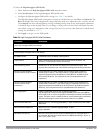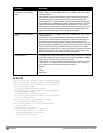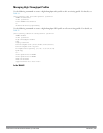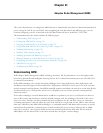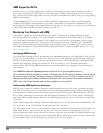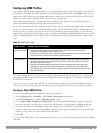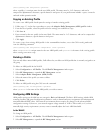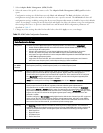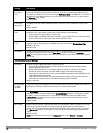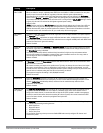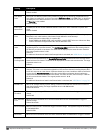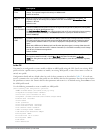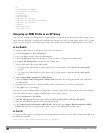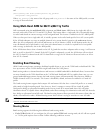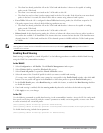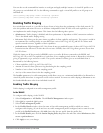
351 | AdaptiveRadioManagement (ARM) DellPowerConnectW-SeriesArubaOS6.2 | User Guide
Setting Description
VoIP Aware
Scan
Dell’s VoIP Call Admission Control (CAC) prevents any single AP from becoming congested with voice
calls. When you enable CAC, you should also enable VoIP Aware Scan in the ARM profile, so the AP will
not attempt to scan a different channel if one of its clients has an active VoIP call. This option requires
that Scanning is also enabled.
Default: disabled
Power Save
Aware Scan
If enabled, the AP will not scan a different channel if it has one or more clients that is in power save
mode.
Default: disabled
Video Aware
Scan
As long as there is at least one video frame every 100mSec the AP will reject an ARM scanning request.
Note that for each radio interface, video frames must be defined in one of two ways:
l Classify the frame as video traffic via a session ACL.
l Enable WMM on the WLAN’s SSID profile and define a specific DSCP value as a video stream. Next,
create a session ACL to tag the video traffic with the that DSCP value.
Minimum Scan
Time
Minimum number of times a channel must be scanned before it is considered for assignment. The
supported range for this setting is 0–2,147,483,647 scans. Dell recommends a Minimum Scan Time
between 1–20 scans.
Default: 8 scans
Scan Mode By default, 802.11n-capable APs scan channels within all regulatory domains. To limit the AP scans to just
the regulatory domain for that AP, click the Scan Mode drop-down list and select reg-domain.
NOTE: This setting does not apply to APs that do not support 802.11n; these APs will scan their regulatory
domain only.
Advanced Configuration Settings
Assignment Activates one of four ARM channel/power assignment modes.
l disable: Disables ARM calibration and reverts APs back to default channel and power settings
specified by the AP’s radio profile
l maintain: APs maintain their current channel and power settings. This setting can be used to
maintain AP channel and power levels after ARM has initially selected the best settings.
l multi-band: For single-radio APs, this value computes ARM assignments for both 5 GHZ (802.11a) and
2.4 GHZ (802.11b/g) frequency bands.
l single-band: For dual-radio APs, this value enables APs to change transmit power and channels
within their same frequency band, and to adapt to changing channel conditions.
Default: single-band
Allowed bands
for 40MHz
channels
The specified setting allows ARM to determine if 40 MHz mode of operation is allowed on the 5 GHz or 2.4
GHz frequency band only, on both frequency bands, or on neither frequency band.
Client Aware If the Client Aware option is enabled, the AP does not change channels if there is an active client
associated to that AP. (Activity is defined by the sta-inactivity-time parameter in the IDS general profile.
By default, a client is considered active if it has sent or received traffic within the last 60 seconds.)
If Client Aware is disabled, the AP may change to a more optimal channel, but this change may also
disrupt current client traffic.
Default: enabled
Max Tx EIRP Maximum effective isotropic radiated power (EIRP) from 3 to 33 dBm in 3 dBm increments. You may also
specify a special value of 127 dBm for regulatory maximum. Higher power level settings may be
constrained by local regulatory requirements and AP capabilities. In the event that an AP is configured
for a Max Tx EIRP setting it cannot support, this value will be reduced to the highest supported power
setting.
Default: 127 dBm
NOTE: Power settings will not change if the Assignment option is set to disabled or maintain.



